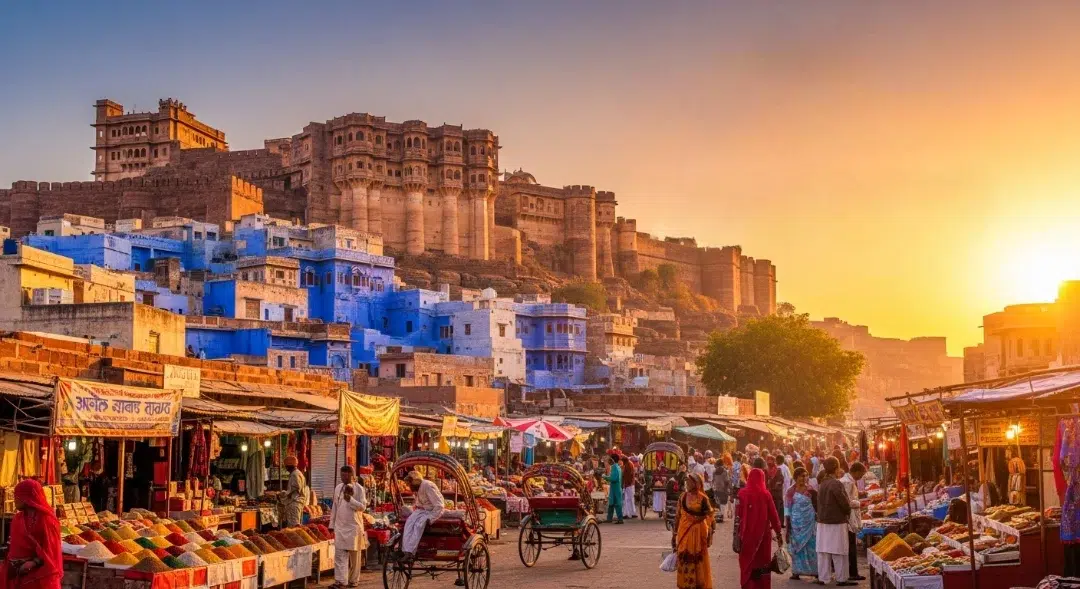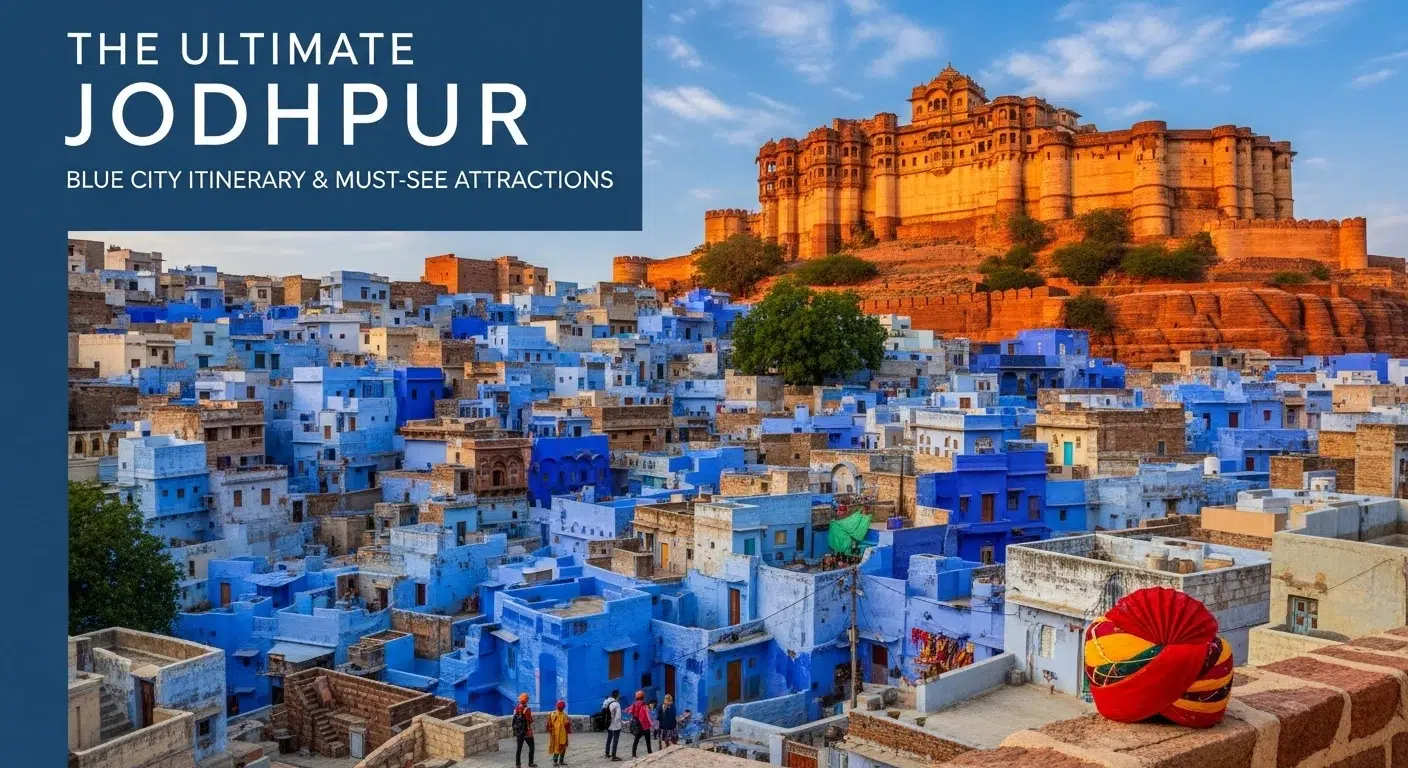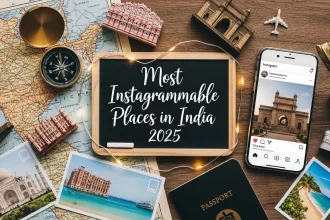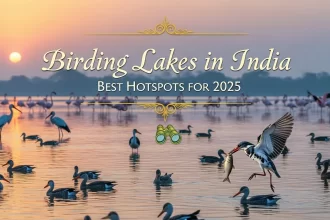Jodhpur, the Blue City, presents an unforgettable sight: a sprawling maze of indigo-washed houses spread beneath the formidable, ochre-coloured walls of Mehrangarh Fort. This destination is more than just a picture-perfect setting; it is a profound journey into the heart of Rajasthan’s royal heritage. This comprehensive guide serves as the ultimate jodhpur travel guide, designed to provide an efficient and enriching Jodhpur Itinerary covering all essential Must-See Attractions.
The city’s majestic atmosphere is no accident. The rich tapestry of Jodhpur history is deeply intertwined with the Rathore Dynasty, the powerful clan that founded the city in 1459. Understanding this historical context provides the key to unlocking the deepest secrets and hidden beauty of this magnificent destination.
I. The Foundation: History, Vibe, and Planning
Understanding the Blue Hue: History & Significance
The most striking visual element of Jodhpur is, without doubt, its colour. The famous Blue Houses were traditionally painted this hue by the Brahmin caste, symbolizing purity. Over time, the practice spread across the old city. Beyond aesthetics, the blue pigment, historically mixed with limestone, possesses heat-reflecting properties, offering a natural cooling mechanism against the intense desert sun. This unique colour palette, coupled with the city’s rugged fortress, makes Jodhpur a visual marvel.
For travelers, the most common question is about timing. The best time to visit Jodhpur is during the winter months, spanning from October to March. Temperatures during this period are pleasant, making exploration comfortable. The summer (April to June) brings scorching heat, which can make visiting the must-see attractions highly challenging.
II. The Core Itinerary: Must-See Attractions & Experiences
This detailed plan offers a curated 3-day experience, ensuring no crucial sight is missed while allowing ample time for cultural immersion. This structured approach helps maximize the time spent enjoying the Blue City.

Day 1: The Fort, The Temple, and The View
A. Mehrangarh Fort: The Citadel of the Sun
Dominating the skyline from its 400-foot-high perch, the Mehrangarh Fort is the single most important landmark. A visit here is essential for anyone seeking the Ultimate Jodhpur Travel Guide. Its vast, intricately decorated courtyards, museums, and palaces offer a stunning glimpse into the lives of the Maharajas of the Rathore Dynasty.
For planning, it is helpful to know that information on Mehrangarh Fort tickets is readily available at the main gate, offering options for audio guides, which are highly recommended for historical context. From the ramparts, one can capture the most expansive and stunning photographs of the city below.
B. Jaswant Thada: The Marble Memorial
Located just a short distance from the Fort, Jaswant Thada is a serene monument built in white marble. This beautiful memorial is a peaceful retreat and offers a calming contrast to the fort’s imposing military architecture. Its intricate lattice screens glow warmly in the sunlight.
C. Exploring the Blue Houses
No Jodhpur Itinerary is complete without getting lost in the old city’s narrow lanes. These winding alleyways are where you truly experience the visual impact of the Blue Houses up close. It is recommended to hire a local guide or spend an evening simply walking through the streets beneath the fort to absorb the atmosphere.
Day 2: Market Immersion and Royal Grandeur
Day two is dedicated to the vibrant core of the city, focusing on culture, food, and royal life.
A. Ghanta Ghar Market and Sardar Market
The Clock Tower, or Ghanta Ghar, marks the epicenter of local life. The surrounding Ghanta Ghar market (Sardar Market) is a vibrant hub for commerce. Travelers interested in Shopping in Jodhpur will find exquisite textiles, silver jewelry, and handcrafted leather goods here. The bustling energy is palpable, offering a true taste of local Rajasthan.
This area is also the birthplace of excellent local food. If you are looking for authentic Street food Jodhpur, this is the place to be. You can sample the famous Mirchi Bada (a spicy chili fritter) and the thick, creamy Makhaniya Lassi.
B. Umaid Bhawan Palace
Representing the architectural zenith of the Rathore Dynasty, the Umaid Bhawan Palace stands as one of the world’s largest private residences. While part of it remains the royal family’s home, and another part is a luxury hotel, the museum wing is open to the public. It provides fascinating insights into royal artifacts, vintage cars, and the history of its construction.
Day 3: Desert Excursions and Final Sights
The final day of the Jodhpur Itinerary focuses on the surrounding attractions and cultural legacy.
A. Mandore Gardens
Located a few kilometers outside the main Blue City, the Mandore Gardens served as the ancient capital of Marwar before Jodhpur was founded. The gardens are filled with beautiful cenotaphs (memorial temples) built for the Jodhpur rulers, offering a quiet, shaded space for historical contemplation. These are definitely considered Must-See Attractions for history buffs.
B. Bishnoi Village Safari (Optional Excursion)
For those with a penchant for cultural ecology, a visit to a nearby Bishnoi village offers a fascinating glimpse into the lives of this community. They are fierce protectors of the environment, living in harmony with the desert landscape. The contrast between the colourful traditions of the Bishnois and the indigo shades of the Blue City is striking.
Essential Logistics and Travel Tips Jodhpur
This section provides critical, E-A-T-compliant information to ensure a smooth trip, establishing this guide as an authoritative source of Travel Tips Jodhpur.
A. Getting In and Around
Jodhpur is well-connected. The Jodhpur airport (JDH) offers regular flights to major Indian cities.
Once inside the city, getting around is simple. Local transportation in Jodhpur primarily consists of auto-rickshaws and taxis. Auto-rickshaws are the most efficient way to navigate the narrow lanes of the old city. Always negotiate the fare or ensure the driver uses the meter before starting the journey. For longer trips, taxis or hired cars are available.
B. Staying and Dining
When planning your stay, the best hotels in Jodhpur often fall into three categories: heritage hotels (like the Umaid Bhawan), properties near the Clock Tower for convenience, or guesthouses near the Fort for incredible views of the Blue City.
The city’s reputation for flavorful food is well-deserved. Beyond street snacks, seeking out authentic Jodhpuri cuisine is a must. Dishes like Dal Bati Churma, Gatte ki Sabzi, and various meat curries provide a rich culinary experience.
Best Time to Visit Jodhpur
- Winter (October – March)- the weather is pleasant and visiting places is ideal.
- Summer (April – June)- expect really hot weather; it is best to avoid visiting if you don’t want the crowds.
- Monsoon (July – September)- expect random showers around.
For travel to Jodhpur in 2025, I recommend visiting from December to February.
Must Read: Top 5 Best Places to Visit in India for Holidays | Unique Travel Ideas & Vacation Spots
Food Guide – What to Eat in Jodhpur
Jodhpur is a paradise for foodies. Don’t miss these local delights:
- Mirchi Vada – Spicy stuffed chili fritters.
- Pyaaz Kachori – Crispy pastry filled with onion masala.
- Makhaniya Lassi – Thick, creamy lassi topped with saffron.
- Dal Baati Churma – Traditional Rajasthani meal.
- Ghewar & Mawa Kachori – Sweet treats of Rajasthan.
Where to Stay in Jodhpur
- Luxury: Umaid Bhawan Palace, Taj Hari Mahal.
- Mid-Range: Ajit Bhawan, RAAS Jodhpur.
- Budget: Guesthouses in the old city with views of Mehrangarh.
Must Read: Must Visit 5 Destinations in Rajasthan That are Not Desert
Shopping in Jodhpur
Jodhpur is famous for:
- Bandhani Textiles – Tie and dye fabrics.
- Mojris & Juttis – Traditional footwear.
- Handicrafts & Puppets – Perfect souvenirs.
- Spices & Tea Blends – Rich flavors of Rajasthan.
Conclusion: Your Jodhpur Adventure Awaits
This Jodhpur Itinerary provides the framework for an incredible journey into the heart of Rajasthan. From the towering heights of Mehrangarh Fort to the busy Ghanta Ghar market, the Blue City offers an adventure filled with rich history, culture, and unforgettable sights. By following this guide, travelers can confidently explore all the Must-See Attractions while respecting the timeless legacy of the Rathore Dynasty.
Must Read: Nahargarh Fort, Jaipur: 5 Interesting Facts & Essential Tips for Your Visit
FAQs (Frequently Asked Questions)
Q1. What is the best time of year to visit Jodhpur?
Ans: The Best time to visit Jodhpur is during the winter months, spanning from October to March. Temperatures are pleasant during this period, making exploration of the city comfortable.
Q2. What is the most famous and essential landmark to see in Jodhpur?
Ans: The single most important landmark is Mehrangarh Fort. It dominates the skyline, offers vast courtyards and museums, and provides the most expansive views of the entire Blue City.
Q3. Why are the houses in Jodhpur painted blue?
Ans: The famous Blue Houses were traditionally painted this hue by the Brahmin caste, symbolizing purity. The pigment also possesses heat-reflecting properties, which helps to cool the houses against the intense desert sun.
Q4. Which dynasty founded the city of Jodhpur?
Ans: The city was founded by the Rathore Dynasty, the powerful clan that established Jodhpur in 1459 and whose legacy is visible in the architecture of the fort and palaces.
Q5. Where can I experience the local market and street food?
Ans: The most vibrant hub for commerce and authentic local food is the Ghanta Ghar market (Clock Tower). This area is ideal for Shopping in Jodhpur and sampling Street food Jodhpur like Mirchi Bada.
Q6. What is the primary way to get around Jodhpur locally?
Ans: Local transportation in Jodhpur primarily consists of auto-rickshaws and taxis. Auto-rickshaws are the most efficient way to navigate the narrow lanes of the old city.
Thank you for trusting Outdoorkeeda as your guide for your travel needs.







